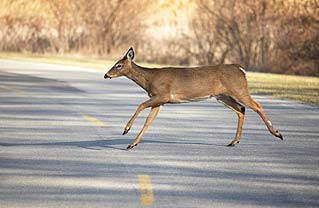U.S. Deer-Vehicle Collisions Fall Seven Percent
 For the third consecutive year, the number of deer-vehicle collisions in the U.S. has dropped. And the downturn is accelerating. The percentage decline over the last year is nearly three times as large as during the previous two years combined. Using its claims data, auto insurer State Farm Insurance estimates 1.09 million collisions between deer and vehicles occurred in the U.S. between July 1, 2010 and June 30, 2011. That's nine percent less than three years ago and seven percent fewer than one year ago.
For the third consecutive year, the number of deer-vehicle collisions in the U.S. has dropped. And the downturn is accelerating. The percentage decline over the last year is nearly three times as large as during the previous two years combined. Using its claims data, auto insurer State Farm Insurance estimates 1.09 million collisions between deer and vehicles occurred in the U.S. between July 1, 2010 and June 30, 2011. That's nine percent less than three years ago and seven percent fewer than one year ago.
Among those states in which at least 2,000 deer-vehicle crashes occur per year, Vermont, Michigan, West Virginia, and Connecticut experienced the largest one-year percentage declines. (There were 23,000 fewer deer-vehicle altercations in Michigan alone.) Michigan is second on the list of states with the highest total number of crashes (78,304), well behind Pennsylvania (101,299).
For the fifth year in a row, West Virginia tops the list of states where an individual driver is most likely to run in to a deer. Using its claims data in conjunction with state licensed driver counts from the Federal Highway Administration, State Farm calculates the chances of a West Virginia motorist striking a deer over the next twelve months at 1-in-53, an improvement over a year ago when the odds were 1-in-42.
Iowa remains second on the list, followed by South Dakota, Pennsylvania, Michigan, Montana, Wisconsin, and Minnesota. North Dakota and Wyoming round out the top ten. In eight of the top ten states (Minnesota and Wyoming are the exceptions), the rate of deer-vehicle collisions per driver went down from a year ago.
The insurer's data shows that November, the heart of the deer migration and mating season, is the month during which deer-vehicle encounters are most likely. More than eighteen percent of all such mishaps take place during the thirty days of November. A confrontation between a deer and a vehicle will occur once every five seconds in the United States in this month and are three times more likely to occur in November than any day between February 1 and August 31.
October is second, followed by December.
The average property damage cost of these incidents during the final half of 2010 and the first half of 2011 was $3,171, up 2.2 percent from the year before.
Here are tips on how to reduce the odds of a deer-vehicle collision:
- Be aware of posted deer crossing signs. These are placed in active deer crossing areas.
- Remember that deer are most active between 6 and 9 p.m.
- Use high beam headlamps as much as possible at night to illuminate the areas from which deer will enter roadways.
- Keep in mind that deer generally travel in herds – if you see one, there is a strong possibility others are nearby.
- Do not rely on car-mounted deer whistles.
- If a deer collision seems inevitable, attempting to swerve out of the way could cause you to lose control of your vehicle or place you in the path of an oncoming vehicle.
 For the third consecutive year, the number of deer-vehicle collisions in the U.S. has dropped. And the downturn is accelerating. The percentage decline over the last year is nearly three times as large as during the previous two years combined. Using its claims data, auto insurer State Farm Insurance estimates 1.09 million collisions between deer and vehicles occurred in the U.S. between July 1, 2010 and June 30, 2011. That's nine percent less than three years ago and seven percent fewer than one year ago.
For the third consecutive year, the number of deer-vehicle collisions in the U.S. has dropped. And the downturn is accelerating. The percentage decline over the last year is nearly three times as large as during the previous two years combined. Using its claims data, auto insurer State Farm Insurance estimates 1.09 million collisions between deer and vehicles occurred in the U.S. between July 1, 2010 and June 30, 2011. That's nine percent less than three years ago and seven percent fewer than one year ago.